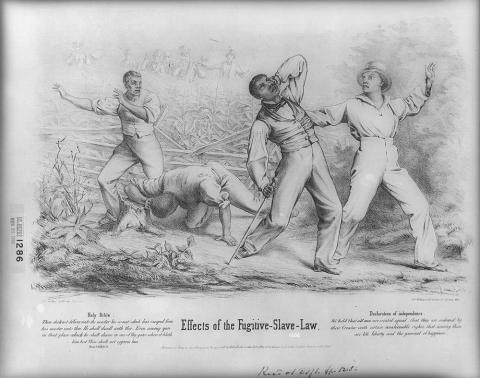
Description
An impassioned condemnation of the Fugitive Slave Act passed by Congress in September 1850, which increased federal and free-state responsibility for the recovery of fugitive slaves. The law provided for the appointment of federal commissioners empowered to issue warrants for the arrest of alleged fugitive slaves and to enlist the aid of posses and even civilian bystanders in their apprehension. The print shows a group of four black men - possibly freedmen - who are being ambushed by a posse of six armed whites in a cornfield. One of the white men fires on them, while two of his companions reload their muskets. Two of the blacks have evidently been hit; one has fallen to the ground while the second staggers, clutching the back of his bleeding head. The two others react with horror. Below the picture are two texts, one from Deuteronomy: "Thou shalt not deliver unto the master his servant which has escaped from his master unto thee. He shall dwell with thee. Even among you in that place which he shall choose in one of thy gates where it liketh him best. Thou shalt not oppress him." The second text is from the Declaration of Independence: "We hold that all men are created equal, that they are endowed by their Creator with certain unalienable rights, that among these are life, liberty and the pursuit of happiness." The print is unusually well drawn and composed for a political print of the period. The handling of both the lithographic technique and the figures betray particular skill.
Transcript from "Effects of the Fugitive-Slave-Law" Illustration
Source-Dependent Questions
- Does this image depict the effects of the Fugitive Slave Act as being a positive or negative? Using the image as evidence, explain your answer.
- Explain the significance of the Bible verse below the image. Does the author believe the effects of the Fugitive Slave Law is God’s will? Explain your answer comparing the image to the meaning of the verse.
- Explain the hypocrisy of the image and the quote from the Declaration of Independence? What is the point the author is trying to make?
Citation Information
Kaufmann, Theodor, "Effects of the Fugitive-Slave-Law," Hoff & Bloede, New York, 1850. Courtesy of Library of Congress